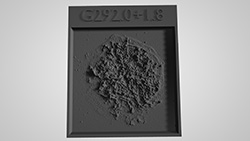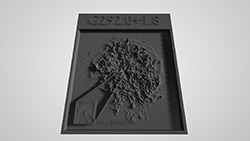CXC Home | Search | Help | Image Use Policy | Latest Images | Privacy | Accessibility | Glossary | Q&A
1
X-ray & Optical Images of G292.0+1.8(Credit: X-ray: NASA/CXC/SAO/L. Xi et al.; Optical: Palomar DSS2)
The G292.0+1.8 supernova remnant contains a pulsar moving at over a million miles per hour, as seen in the Chandra image along with an optical image from the Digitized Sky Survey. Pulsars are rapidly spinning neutron stars that can form when massive stars run out of fuel, collapse, and explode. Sometimes these explosions produce a "kick," which sent this pulsar racing through the remains of the supernova explosion. Additional images show a close-up look at this pulsar in X-rays from Chandra, which observed it both in 2006 and 2016 to measure this remarkable speed. The red crosses in each panel show the position of the pulsar in 2006.
2
Close-up View of Pulsar Motion(Credit: X-ray: NASA/CXC/SAO/L. Xi et al.; Optical: Palomar DSS2)
A close-up view of the center of the Chandra image of G292+1.8. The direction of motion of the pulsar is shown (arrow), and the position of the center of the explosion (green oval) based on the motion of debris seen in optical data. The position of the pulsar is extrapolated back 3,000 years and the triangle depicts the uncertainty in the angle of the extrapolation. Agreement of the extrapolated position with the center of the explosion gives an age of about 2,000 years for the pulsar and G292+1.8. The center of mass (cross) of X-ray-detected elements in the debris (Si, S, Ar, Ca) is on the opposite side of the center of the explosion from the moving pulsar. This asymmetry in the debris to the upper right of the explosion resulted in the pulsar being kicked to the lower left, by conservation of momentum.
4
3D Printable Files: G292 Chandra Tactile Plate (3D Print Credit: NASA/CXC/A. Jubett, using software by Tactile Universe/N. Bonne & C. Krawczyk & Blender)
This tactile plate depicts supernova remnant G292, as a physical relief map based on the intensity of the X-ray data captured by Chandra. The file for this plate can be downloaded and 3D-printed for learners to touch.
The G292.0+1.8 supernova remnant contains a pulsar moving at over a million miles per hour, as marked in the Chandra image. Pulsars are rapidly spinning neutron stars that can form when massive stars run out of fuel, collapse, and explode. Sometimes these explosions produce a “kick,” which sent this pulsar racing through the remains of the supernova explosion.
The G292.0+1.8 supernova remnant contains a pulsar moving at over a million miles per hour, as marked in the Chandra image. Pulsars are rapidly spinning neutron stars that can form when massive stars run out of fuel, collapse, and explode. Sometimes these explosions produce a “kick,” which sent this pulsar racing through the remains of the supernova explosion.
Return to: NASA's Chandra Catches Pulsar in X-ray Speed Trap (June 15, 2022)











